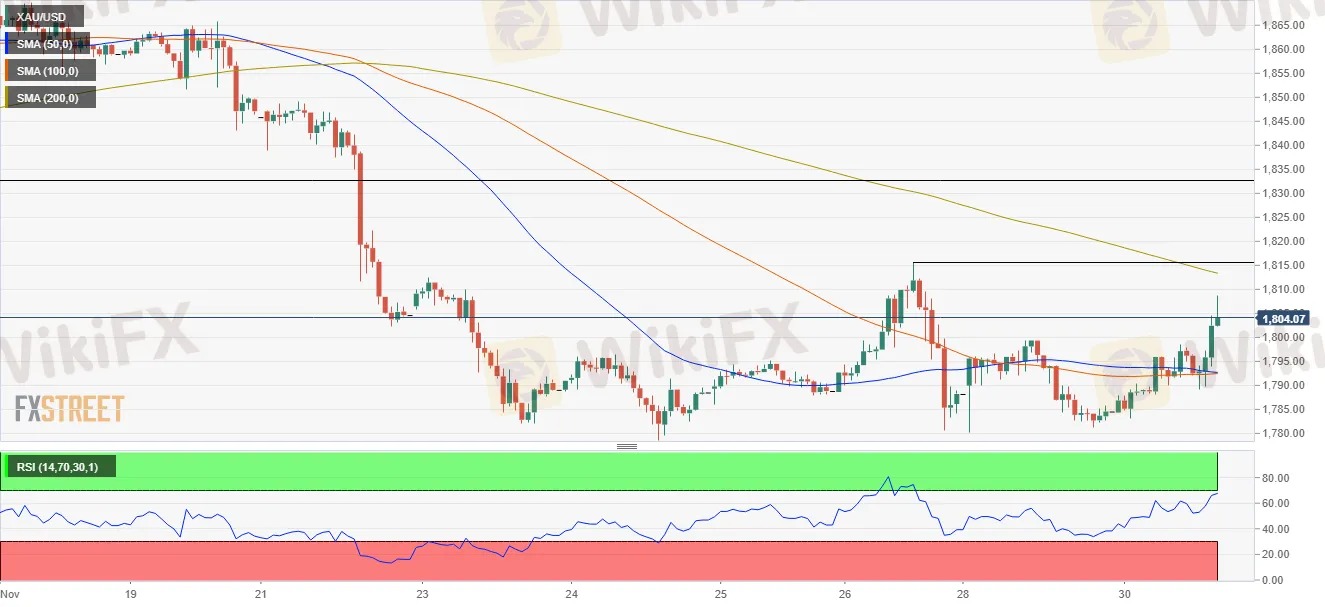简体中文
繁體中文
English
Pусский
日本語
ภาษาไทย
Tiếng Việt
Bahasa Indonesia
Español
हिन्दी
Filippiiniläinen
Français
Deutsch
Português
Türkçe
한국어
العربية
Gold Price Forecast: XAU/USD surges above $1,800 on falling US T-bond yields
Abstract:Gold advances firmly, as US-10 year T-bond yields drop ten basis points, down to 1.43%. Risk-off market sentiment boosted the prospects of the XAU/USD, as the COVID-19 omicron variant threatens to derail the economic growth. XAU/USD Technical outlook: A break above $1,807 would expose $1,815, followed by $1,834.
Gold (XAU/USD) edges high during the New York session, jumping from $1,780 daily low earlier in the day towards $1,807 at press time, amid comments of Moderna‘s CEO in an interview with the Financial Times, predicted a drop in existing vaccines efficacy, spurring a flight to safe-haven assets, as portrayed by US equity futures indices falling, ahead of the Wall Street’s open.
That boosted the prospects of the yellow metal, which has strengthened on the back of falling US T-bond yields, acting as a headwind for the greenback. The US 10-year Treasury yield is plummeting ten basis points, sitting at 1.43%, while the US Dollar Index, which measures the greenbacks value against a basket of its peers, falls sharply 0.74%, breaking below the 96.00 threshold, sitting at 95.65 at press time.
It seems that market participants are focused on the coronavirus omicron developments and its impact on the global economy. The fall in US bond yields reflects investors postures, scaling back bets of Fed hiking rates from three to two increases, depending on the ongoing COVID-19 developments.
Therefore, gold has and will keep benefitting from the abovementioned, unless data of the omicron variant show that despite being contagious, it would not be as dangerous as another COVID-19 variant.
The US macroeconomic docket so far featured the S&P/Case-Shiller Home Price Index (MoM) for September, which rose by 19,1%, more than the 19.3% expected. Meanwhile, the Chicago Purchasing Managers Index for November increased to 61.8, lower than the 67 estimated.
XAU/USD Price Forecast: Technical outlook
Gold in the 1-hour chart is approaching resistance at the R2 daily pivot level at $1,807. The 50 and the 100-hour simple moving averages (SMAs) were left behind around the $1,796 area, while the 200-hour SMA lies in the confluence of the R3 daily pivot at $1,815, which is also the November 26 high.
On the way up, $1,815 would be the most robust line of defense for USD bulls, which in the case to be broken, would expose the September 3 high at $1,834.
On the flip side, failure to break above the former would expose the $1,800 figure, followed by the confluence of the 50 and the 100-hour SMAs around the $1,892-94 range.

Disclaimer:
The views in this article only represent the author's personal views, and do not constitute investment advice on this platform. This platform does not guarantee the accuracy, completeness and timeliness of the information in the article, and will not be liable for any loss caused by the use of or reliance on the information in the article.
Read more

Breakthrough again! Gold breaks through $2530 to set a new record high!
Spot gold continued its record-breaking rally as investors gained confidence that the Federal Reserve might cut interest rates in September and gold ETF purchases improved. The U.S. market hit a record high of $2,531.6 per ounce

Historic Moment: Gold Surges Above $2,500 Mark, Forging Glory!
Boosted by the weakening of the US dollar and the expectation of an imminent rate cut by the Federal Reserve, spot gold broke through $2,500/ounce, setting a new record high. It finally closed up 2.08% at $2,507.7/ounce. Spot silver finally closed up 2.31% at $29.02/ounce.

Weekly Analysis: XAU/USD Gold Insights
Gold prices have been highly volatile, trading near record highs due to various economic and geopolitical factors. Last week's weak US employment data, with only 114,000 jobs added and an unexpected rise in the unemployment rate to 4.3%, has increased the likelihood of the Federal Reserve implementing rate cuts, boosting gold's appeal. Tensions in the Middle East further support gold as a safe-haven asset. Technical analysis suggests that gold prices might break above $2,477, potentially reachin

【MACRO Insight】Monetary Policy and Geopolitics - Shaping the Future of Gold and Oil Markets!?
In the ever-evolving global economy, the intertwining influences of monetary policy and geopolitical factors are reshaping the future of the gold and crude oil markets. This spring, the gold market saw a significant uptrend unexpectedly, while Brent crude oil prices displayed surprising stability. These market dynamics not only reflect the complexity of the global economy but also reveal investors' reassessment of various asset classes.
WikiFX Broker
Latest News
Exposing the Top 5 Scam Brokers of March 2025: A Closer Look by WikiFX
Gold Prices Climb Again – Have Investors Seized the Opportunity?
Webull Launches SMSF Investment Platform with Zero Fees
Australian Regulator Warns of Money Laundering and Fraud Risks in Crypto ATMs
FCA Warns Against 10 Unlicensed or Clone Firms
CySEC Warns Against 14 Unlicensed Investment Websites
Top Currency Pairs to Watch for Profit This Week - March 31, 2025
Will natural disasters have an impact on the forex market?
Philippines Deports 29 Indonesians Linked to Online Scam Syndicate in Manila
AI-Powered Strategies to Improve Profits in Forex Trading
Currency Calculator







